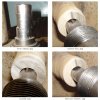I've never used a pin chuck, and I don't fully understand how one works. Does anyone know where I can get some information on how it works, along with detailed pictures of it.
I'm wanting to make a small one, one that fits a hole about 1/4" in diameter. I have access to a machine shop, so I should be able to do this if I can figure out what they look like, and how they work. Any information would be appreciated. Thanks,
Matt
I'm wanting to make a small one, one that fits a hole about 1/4" in diameter. I have access to a machine shop, so I should be able to do this if I can figure out what they look like, and how they work. Any information would be appreciated. Thanks,
Matt


